“], “filter”: { “nextExceptions”: “img, blockquote, div”, “nextContainsExceptions”: “img, blockquote, a.btn, a.o-button”} }”>
When your digestive system is out of whack, you’d be wise to turn to yoga. In fact, practicing yoga poses for constipation may offer you gentle relief and lessen the likelihood of a chronic problem. Practicing yoga poses and diaphragmatic breathing work to massage the abdomen so that your internal organs can get to work.
How Yoga Can Ease Constipation
If elimination is difficult, incomplete, or infrequent (less than three times per week), drinking more water and adding fiber-rich foods to your diet can ease constipation. Physical activity also stimulates the muscles in your intestine. That’s where yoga comes in.
Certain yoga poses—particularly twists and poses that place pressure on the stomach—gently massage your abdomen, encouraging it to move waste along. In fact, a 2015 study found that yoga can ease symptoms of Irritable Bowel Syndrome, which often includes bouts of constipation.
Yoga also affects the vagus nerve which sends signals from your brain to your gut. Stimulating the vagus nerve activates anti-inflammatory properties which can restore equilibrium in the microbiota-gut-brain axis, according to a 2018 study.
That’s just the physical part. There’s an added benefit when it comes to practicing yoga poses for constipation: The stress-reducing qualities of the practice can activate your parasympathetic nervous system, which helps you “rest and digest,” so your GI system works efficiently.
Can You Avoid the Causes of Constipation?
Any number of conditions can cause your digestive tract to feel sluggish or blocked. Constipation can be caused by stress, travel, being sedentary, not eating enough fiber, or not drinking enough water.
A new study found that people who had COVID were more likely to have gastrointestinal problems, including constipation, for as long as a year after being diagnosed with the virus. More severe the virus symptoms were associated with a higher risk of intestinal problems.
People who have Parkinson’s, multiple sclerosis, stroke, or nerve damage can also be at risk of constipation. Certain medications can also prevent your colon from absorbing enough water from the food you eat so it can be easily eliminated.
Yoga Poses for Constipation Relief
While yoga isn’t a cure-all for the conditions that cause sluggish digestion, your practice may bring you some comfort. Try these poses when you are feeling stuck. (Full instructions can be found at the Yoga Journal Pose Library.)
1. Bhujangasana (Cobra Pose)
Cobra is an integral part of vinyasa flows, but it’s also an excellent pose for putting pressure on the abdomen.
- Lie on the floor with your legs stretched out behind you at least hip-width apart. Fold a blanket under your stomach and hips for more comfort. Place your hands under your shoulders and hug your elbows toward your body.
- Press the tops of your feet and thighs firmly into the floor.
- As you inhale, press your hands into the floor to lift your chest slightly off the floor. Firm your glutes as you lift your pubis toward your navel.
- Lift your sternum and release your shoulders away from your ears.
- Stay here for up to 30 seconds, then lower back to the floor.
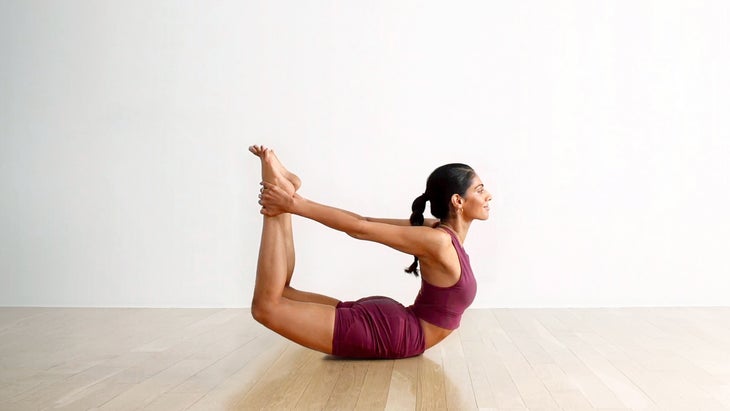
2. Dhanurasana (Bow Pose)
Like Cobra Pose, Dhanurasana puts pressure on the abdomen, which can help get things moving and keep you regular. This is an intense backbend, so only attempt it at the end of a sequence after working up to it from gentler back bends.
- Lie on your belly and bend your knees to bring your heels close to your glutes.
- Reach back to take hold of your ankles or loop a strap around your feet.
- Inhale and lift your heels away from your glutes while lifting your thighs. Pull your head and upper torso off the floor.
- Press your shoulder blades firmly against your back to open your heart. Remember to keep breathing.
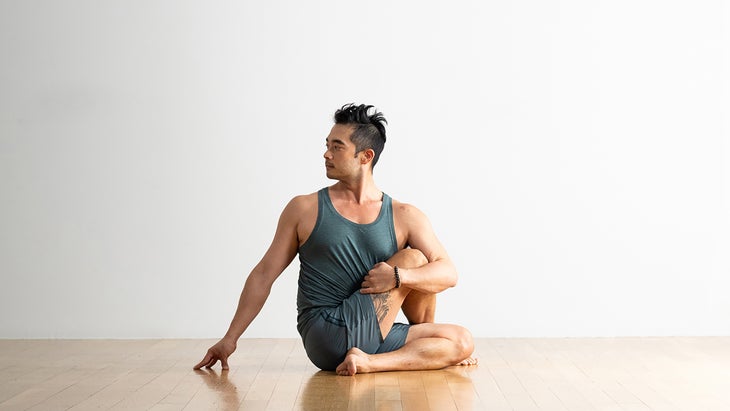
3. Ardha Matsyendrasana (Half Lord of the Fishes Pose)
The twisting action of Ardha Matsyendrasana is believed to help stimulate movement along the digestive tract.
- Start seated with your legs straight in front of you. Bend your right knee and bring the sole of your foot to the floor outside of your left thigh. Keep your left leg straight or bend your left knee and tuck your foot in by your right glute.
- Exhale and twist toward your right thigh. Press your right hand on the floor behind you. Hold your right knee with your left hand or wrap your left forearm around your right shin and thigh.
- Turn your gaze over your right shoulder as you twist from your belly.
- Each time you inhale, lift through your sternum. As you exhale, twist a little more. When you are ready return to your original position and repeat on the opposite side.
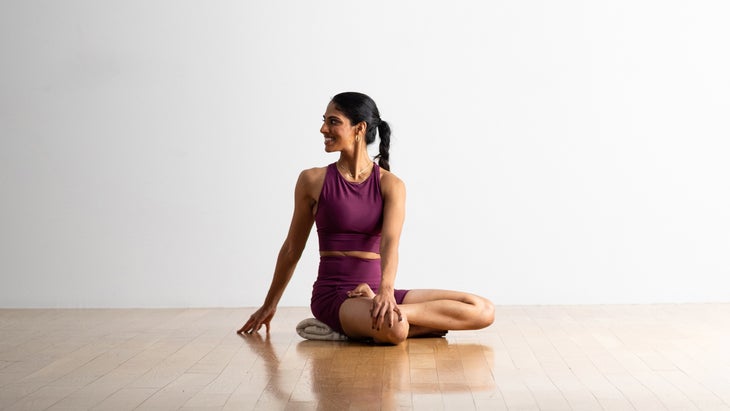
4. Bharadvajasana (Bharadvaja’s Twist)
Like Half Lord of the Fishes Pose, Bharadvajasana is a seated twist that puts pressure on the abdomen to help with constipation and other digestive concerns.
- Sit in a cross-legged position on the floor or on a folded blanket.
- Place your left hand on your right knee, and take your right hand to the floor behind your right hip.
- Inhale and lengthen your spine; exhale and twist your torso to the right, taking your gaze to right. When you are ready, return to center and twist to the opposite side.

5. Reclined Twist
Practicing a twist while lying down brings the same benefits as a seated twist with less effort and less strain on your lower back.
- Lie on your back with your knees bent and your feet on the floor. Extend your arms out from your shoulders in a T shape.
- Lift your feet off the floor and draw your knees toward your ribs.
- Roll to your left side, keeping your knees bent as you turn. If one or both knees don’t reach the floor, place a blanket or bolster beneath or between them for support.
- Turn your head to look to the right. When you are ready, return to starting position and repeat on the opposite side.
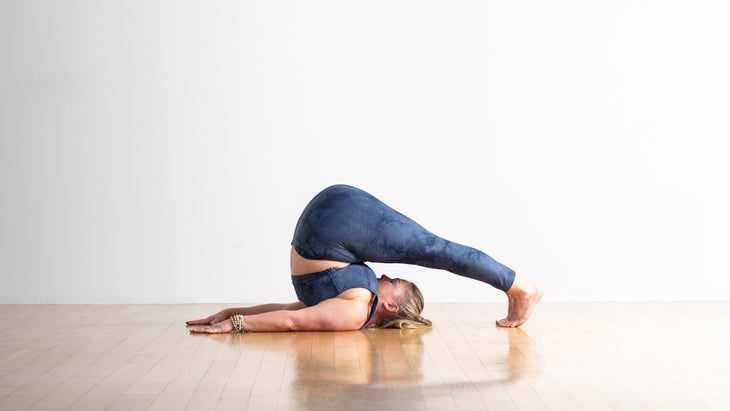
6. Halasana (Plow Pose)
Plow is known for easing backache, but this inversion also gently compresses the abdominal organs to bring relief for constipation.
- Stack three blankets so that their edges line up near the middle of the mat. Lie back so that the tops of your shoulders are about an inch over the edge.
- Bend your knees and set your feet close to the buttocks, then exhale and bring your knees toward your chest.
- Using your abs and the support of your hands at your low or mid back, lift your hips off the floor and roll up until you are supported by your shoulders.
- Slowly extend your legs straight back over your head. Flex your feet and rest your toes on the ground.
- Support your back with your hands, keeping the elbows close to your body. You may also release your hands and place your arms on the floor.
- To come out of the pose, slowly roll down until your back is on the mat.
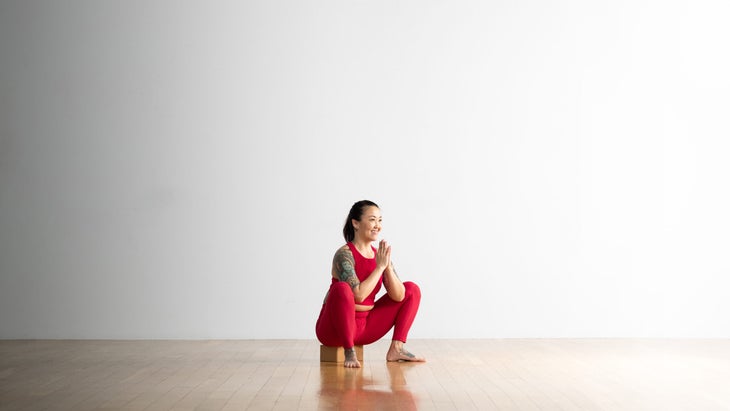
7. Malasana (Garland or Squat Pose)
Squatting is said to put your colon in the best position for efficient elimination.
- Squat with your feet either hip-distance apart and rest your sitting bones on a block. (Keep your heels on the floor or rest them on a pillow or a rolled blanket.
- Separate your thighs slightly wider than your torso. Exhale and lean your torso forward and fit it against or in between your thighs.
- Bringing your palms together in Anjali Mudra (Salutation Seal), press your elbows against your inner knees, resisting with the strength of your legs.
This article has been updated. Originally published April 23, 2021.
RELATED: Beat Bloating: 5 Daily Ayurvedic Tricks for Better Digestion

